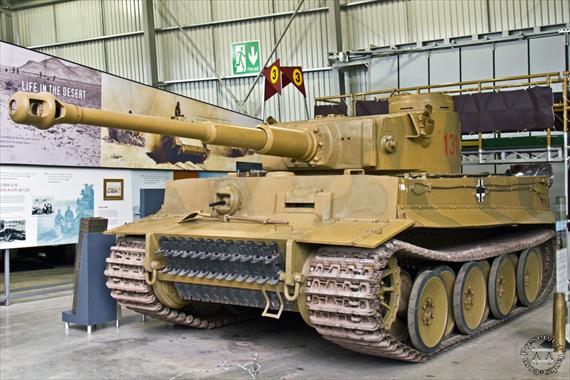
|
|
Unique ID:
|
72
|
|
Added to Database:
|
May 2008
|
|
Last Edited:
|
30 December 2011
|
|
Type (ID):
|
Tiger (170)
|
|
Model (ID):
|
Early Production Model (300)
|
|
Location Category (ID):
|
The Tank Museum - Public Areas (3000)
|
|
Location (ID):
|
Tank Story Hall (3004)
|
|
Serial Number: |
250112: chassis number.
|
|
Registration: |
|
|
Name: |
|
|
Other Identification: |
“131” painted in red on turret sides. Unit markings painted on forward hull sides. German crosses painted on hull sides. Painted overall in a sand and brown camouflage scheme.
|
|
Collection Reference: |
E1951.23. (Accession 2351, Entry 1951.1014).
|
|
Links: |
|
|
References: |
|
|
Associated Tanks: |
|
Location History:
(see map) |
1: Wegmann & Co, Kassel, Nordhessen, Germany (Turret manufacturer)
2: Henschel und Sohn, Kassel, Nordhessen, Germany (Chassis manufacturer and vehicle assembly)
3: Medjez-el-Bab, Tunisia (In action 21 April 1943)
4: Djebel Djaffa, Tunisia (Recovered west of Goubellat or Quballat 22 April 1943)
5: Tunis, Tunisia (June 1943)
6: La Goulette, Tunisia (Driven to Port 26 June 1943)
7: Port Docks, Bizerte, Bizerte Governorate, Tunisia (Arrived by LCT 3 August 1943)
8: Bône now Annaba, Algeria (11 August-20 September 1943)
9: Directorate of Tank Design, Chertsey, Surrey, South East England, Britain (From September 1943)
10: Horse Guards London, Britain (November 1943)
11: Directorate of Tank Design, Chertsey, Surrey, South East England, Britain (From September 1943)
12: The Tank Museum - Public Areas, Bovington, Dorset, South West England, Britain (Current location)
13: The Tank Museum - Tankfest Arena, Bovington, Dorset, South West England, Britain (Various TankFests)
14: The Tank Museum - Public Areas, Bovington, Dorset, South West England, Britain (Current location)
|
Text in original Preserved German Tanks publication:
This early production Tiger, carrying the turret number “131”, was the Troop Leader’s tank of 3rd Troop of Number 1 Company, sPzAbt 504, sent to Tunisia in early 1943. In April 1943 it was part of a force that successfully attacked units of the British First Army in the area of Medjez-el-Bab. On the afternoon of 21 April a counter-attack was made by A Squadron of 48 RTR, 21st Army Tank Brigade, equipped with Churchill Mark IV tanks. During the ensuing battle a number of Churchills were lost but this Tiger was hit by two 6pdr shells from another Churchill, one wounding the tank commander and the other jamming the turret. The tank was then abandoned by its crew.
The next day, 22 April, it was recovered by the British, having been found to be otherwise undamaged, near Djebel Djaffa. It became the first Tiger in good condition recovered by Allied forces. It was refurbished by 104 Army Tank Workshop REME with captured spare parts and by June 1943 was on display in Tunis. There it was a major attraction and was visited by the King, the Prime Minister and many other VIPs. In September 1943 it was sent to the School of Tank Technology at Chertsey for detailed examination. At Chertsey it was stripped down and a report was prepared by the STT staff, including Peter Gudgin who had been a troop leader in one of the tanks destroyed by the Tiger on the day it was disabled. After spending some time at Chertsey, and briefly being exhibited on Horse Guards’ Parade in London, it was moved to Bovington after the war. It has the chassis number 250112 (source: L. Archer) although some sources give it as 250122.
This Tiger is currently not on display to the public. It is planned to restore it to running order and so in 1989 it was removed from the museum and disassembled. The gearbox was restored near Stuttgart in 1990 with the help of Maybach engineers (source: Military in Scale magazine). The original engine was sectioned for display and so the one from the museum’s Tiger II will be used in its place. The hull restoration continues but is being delayed by lack of funds. Contributions for the Tiger Project can be sent to the museum. The turret can still be seen on display in the museum while it awaits restoration.
Text in Preserved German Tanks Update:
On 26 June 1943 it was driven to the port of La Goulette for shipment on LCT 568, arriving in Bizerte on 3 August; it was then transferred to the ‘SS Empire Candida’ for the journey to Bône, where it was discharged on 11 August. It finally left North Africa for UK in the ‘SS Ocean Strength’ on 20 September 1943. (Source: The Tiger Tanks, P. Gudgin).
It took part in TankFest 2008 and 2009, and was moved from the World War 2 Hall to the Tank Story Hall in 2009. It was then removed from display for part of the 2010/11 winter for maintenance evaluation, and was just a static exhibit at TankFest 2011.
|